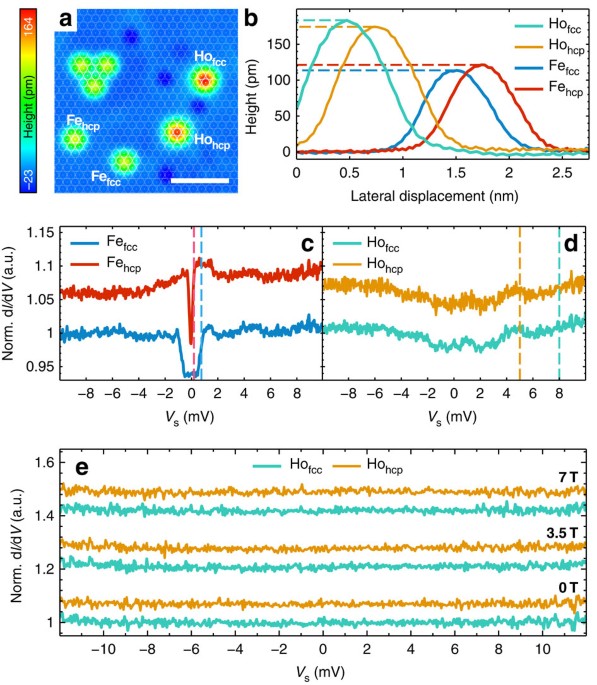
- Select a language for the TTS:
- UK English Female
- UK English Male
- US English Female
- US English Male
- Australian Female
- Australian Male
- Language selected: (auto detect) - EN
Play all audios:
ABSTRACT Whether rare-earth materials can be used as single-atom magnetic memory is an ongoing debate in recent literature. Here we show, by inelastic and spin-resolved scanning
tunnelling-based methods, that we observe a strong magnetic signal and excitation from Fe atoms adsorbed on Pt(111), but see no signatures of magnetic excitation or spin-based telegraph
noise for Ho atoms. Moreover, we observe that the indirect exchange field produced by a single Ho atom is negligible, as sensed by nearby Fe atoms. We demonstrate, using _ab initio_ methods,
that this stems from a comparatively weak coupling of the Ho 4_f_ electrons with both tunnelling electrons and substrate-derived itinerant electrons, making both magnetic coupling and
detection very difficult when compared to 3_d_ elements. We discuss these results in the context of ongoing disputes and clarify important controversies. SIMILAR CONTENT BEING VIEWED BY
OTHERS ELECTRICALLY DRIVEN SPIN RESONANCE OF 4_F_ ELECTRONS IN A SINGLE ATOM ON A SURFACE Article Open access 20 June 2024 COMPLETE REVERSAL OF THE ATOMIC UNQUENCHED ORBITAL MOMENT BY A
SINGLE ELECTRON Article Open access 27 August 2020 MAGNETIC MOLECULES AS LOCAL SENSORS OF TOPOLOGICAL HYSTERESIS OF SUPERCONDUCTORS Article Open access 04 July 2022 INTRODUCTION Using the
magnetic moment of a single atom adsorbed on non-magnetic surfaces to store and process information is one of the major goals in the field of nano-spintronics1. A key ingredient towards
realizing single-atom magnets is the large magnetic anisotropy energy2, which defines an energy barrier between various orientations of the magnetic moment and has been found to be
extraordinarily large for single 3_d_ atoms, like Co, adsorbed directly on metallic surfaces3. However, strong hybridization of the 3_d_ states makes the magnetic moment susceptible to
substrate-driven interactions, like spin-flip scattering by conduction electrons4, diminishing the stability of the magnetic moment against fluctuations. One route towards increasing the
magnetic stability of single-atom magnets is to use strong exchange coupling between a small number of magnetic atoms, thereby increasing the effective energy needed to reverse the
magnetization of the atomic ensemble. Towards this end, it was demonstrated that a small number of strongly coupled Fe atoms in an array5 or a chain6,7, either ferro- or
antiferromagnetically coupled, can be controllably stabilized into a given state from seconds to hours. It was also proposed that, by combining a particular choice of symmetry, magnetic
moment and strong uniaxial anisotropy, the spin can be protected from quantum tunnelling of the magnetization and substrate-driven relaxation8,9,10. Experimentally, based on this concept,
Miyamachi _et al._8 claim to stabilize a single Ho atom on Pt(111). This realization is motivated by a key property of bulk 4_f_ magnetism; the spin resides in the 4_f_ orbitals, which are
strongly localized to the nucleus and only couple to the itinerant electrons via intra-atomic exchange paths through the 5_d_- and 6_s_-orbitals11 and therefore the 4_f_ orbitals only
negligibly contribute to the tunnelling current12. This property of 4_f_ elements hypothetically allows for a weaker degree of hybridization as compared with the 3_d_ counterparts, when
adsorbed onto metallic surfaces. However, there has been recent controversy about this claim, stemming from disagreement about the magnetic properties of Ho/Pt(111). X-ray magnetic circular
dichroism (XMCD) measurements13 reveal no evidence of magnetic stability and a different ground state configuration for Ho/Pt(111) compared with ref. 8, which violates the theoretical
criterion proposed by Miyamachi _et al._8. To clarify this controversy and understand if tunnelling-based spectroscopy can reveal the magnetism of 4_f_ elements, we revisit Ho atoms on
Pt(111) with spin-resolved tunnelling spectroscopy at _T_=0.3 K. In stark contrast to what is reported by Miyamachi _et al._8, we see no evidence of spin-excitations or spin-polarized
telegraph noise on these atoms. The findings were corroborated by concurrently performed experiments with Fe atoms on the same surface, where the magnetic properties of this system are
well-known14 and confirm our spin-sensitivity. Furthermore, by monitoring the changes in spin-excitations of a single Fe atom, we find that the indirect exchange fields produced by a nearby
Ho atom cannot be detected. These findings, as illustrated by _ab initio_ methods, stem from a weak interaction of the 4_f_ orbitals with the surrounding electronic environment, which
thereby makes the Ho magnetic moment difficult to access by both tunnelling methods and indirect exchange pathways. RESULTS INELASTIC TUNNELLING SPECTROSCOPY OF SINGLE HO AND FE ATOMS In
constant-current scanning tunnelling microscopy (STM) images, Ho and Fe atoms can easily be distinguished by their different apparent heights, which are ≈180 pm for Ho and ≈120 pm for Fe
atoms, respectively (Fig. 1a,b). We observe that the apparent height of the Ho atom depends strongly on the bias voltage _V_s applied to the sample with a maximum of ≈205 pm at _V_s=1.5 V
(see Supplementary Note 1 and Supplementary Figure 2), in excellent agreement with the results of Donati _et al._13. These values significantly deviate from what was published by Miyamachi
_et al._8, where apparent heights above 220 pm (_V_s=1 V) have been reported. We find small differences in the apparent height for fcc and hcp atoms. Interestingly, the Fehcp atoms appear
higher than Fefcc, whereas Ho atoms show the opposite behaviour (Fig. 1b). With a given tip, inelastic scanning tunnelling spectroscopy (ISTS) on the Fe atoms reveals the previously
reported14 adsorption-site-dependent spectroscopic signature of a spin-excitation with a different energy for Fefcc and Fehcp sites. They are located at 0.75 meV and 0.19 meV (dashed lines
in Fig. 1c), with step heights of 8% and 12% of the signal at zero bias, respectively. Knowing the adsorption site, tip-induced atom manipulation has been used to assemble artificial
arrangements of Hofcc, Hohcp, Fefcc and Fehcp on clean areas of the Pt(111) substrate, which we used for subsequent investigations of their magnetic properties (Fig. 1). Typical manipulation
parameters are _V_s=2 mV at a stabilization current of _I_stab=50 nA for Fe, while Ho already moves at 30 nA. We first performed magnetic field (_B_)-dependent ISTS and spin-resolved
measurements on isolated Ho atoms which were far from other atoms. Using the same microtip as for ISTS on Fe (Fig. 1c) the differential tunnelling conductance (d_I_/d_V_) signal on Hofcc and
Hohcp is featureless and shows no reproducible inelastic signal distinguishable from the substrate spectrum (Fig. 1d). In particular, there is no indication for a spin-excitation at the
previously reported energies of 5 meV and 8 meV for Hofcc and Hohcp, respectively8 (see dashed lines in Fig. 1d). Moreover, the spectra in an energy window of ±12 meV do not change in a
magnetic field up to 7 T (Fig. 1e). This rules out that spin-excitations emerge in a magnetic field at low energy due to negligible magnetic anisotropy15. We performed the same experiment
with several tens of different microtips and atoms with stabilization currents up to 50 nA and modulation voltages reaching 3 mV using a second lock-in amplifier to measure the second
derivative signal in parallel to (d_I_/d_V_) (see Supplementary Note 2), to directly compare with the method used by Miyamachi _et al._8. Several spectra with different parameters have been
taken and are shown exemplarily in Supplementary Figures 3–5 in Supplementary Note 2. The noise level in these measurements was ±0.5 μA V−2 (see Supplementary Note 2). Nevertheless, we did
not see any inelastic signatures unique to the Ho atom, regardless of the various parameters. It is important to note that tip-related features which appear as variations in the substrate
spectra could not be fully removed from the spectra measured on the atoms by subtracting a substrate spectrum measured with the same tip. For all microtips we used, the minimum signal
variation due to this effect was ±2 μA V−2 (see Supplementary Note 2). We remark, however, that the intensity of the inelastic signal was not specified by Miyamachi _et al._8. SPIN-RESOLVED
MEASUREMENTS OF HO AND FE3 As XMCD measurements clearly indicate the presence of a magnetic moment of Ho on Pt(111)13, the lack of ISTS signal questions if the tunnelling electrons
sufficiently exchange couple with the 4_f_-derived magnetic moment of the Ho atom16,17. Another approach to probe this is to employ spin-resolved tunnelling, which is sensitive to the
spin-polarization in the vacuum18. To perform such measurements, we created a magnetic tip by intentionally picking up Fe atoms from the substrate to the tip, until spin-sensitivity was
achieved. The spin-sensitivity to the out-of-plane component of the magnetization was quantified by recording the magnetic telegraph noise of the tip height Δ_Z_ on an artificially
constructed array of three Fe atoms (Fe3-array, Fig. 2a,b). The magnetization of this array switches between two degenerate ground states with opposite out-of-plane magnetization components
(red and blue in Fig. 2b) similar to Fe5 on Cu(111)5, as proven by an increase in the asymmetry of the residence times in the two states with _B_. The observed telegraph noise has a strength
of Δ_Z_≈15 pm on a noise level of 0.3 pm (r.m.s., time averaging 20 ms). Using the Fe3 as a calibration, we employ tips which showed the above-mentioned contrast to probe individual Ho
atoms (Fig. 2b,c). Time traces with calibrated tips and various combinations of the parameters _I_stab (0.5 to 50 nA), _V_s (3 to 10 mV), _B_ (−0.2 to 0.2 T) and recording times _t_ (200 to
1,600 s), which include the choices of parameters of Miyamachi _et al._8, have been recorded on 13 different Ho atoms (see Supplementary Table 1 in Supplementary Note 3 for the list of
parameter combinations). The 39 time traces (Fig. 2d) do not show any indication for the magnetic telegraph noise that has been reported in ref. 8, within a noise level specified above.
Recent measurements using XMCD reported a mixture of _J__z_=±6 with an almost quenched expectation value along the surface normal as the magnetic ground state of Ho on Pt(111)13. While this
would explain the observed absence of telegraph noise in our magnetic measurements in contrast to Miyamachi _et al._8, the corresponding spin-Hamiltonian still enables spin-excitations at a
few meV energy, which we do not observe. Therefore, the lack of inelastic and spin-polarized signal from Ho questions if tunnelling-based methods are sensitive enough to interrogate the
magnetism of 4_f_ single-atom moments. We discuss the latter point in more detail later, by comparing the experimental observations with the calculated electronic structure. STUDY OF THE
MAGNETIC INTERACTION BETWEEN HO AND FE ATOMS It is well-known that magnetic order of bulk 4_f_ materials is mediated by indirect exchange interactions via exchange of the 4_f_ electrons with
5_d_ and 6_s_ itinerant electrons11. At the single-atom limit, it is interesting to ask if the exchange fields produced by single Ho atoms on surfaces behave similar to the bulk. Therefore,
we use an Fe atom in close proximity to Ho and monitor the changes of the magnetic excitation of Fe, to probe the indirect exchange field produced by Ho. We have shown in an earlier
publication that the Pt(111) substrate mediates an RKKY interaction between two Co atoms adsorbed on the surface with a strength on the order of hundreds of μeV for pair separations in the
range of 10 Å (ref. 19). Using atom manipulation, we have built several pairs containing one fixed Fehcp atom and a Ho atom that was moved to different lattice sites (both fcc and hcp),
resulting in various distances between the Fehcp and the Ho (Fig. 3a). For each pair, we performed ISTS on both atoms (Fig. 3b,c). Remarkably, we observe the following two points: first, the
spectra of the coupled Ho atoms do not change regardless of separation or applied magnetic field (Fig. 3 and Supplementary Note 4), and second the spectra of the coupled Fehcp atom also do
not change for separations larger than 5.55 Å (Fig. 3). It was previously shown that a signature of exchange fields between a pair of atoms can be detected as a perturbation to the spin
excitation20. The lack of any significant changes to the Fe excitations indicate that the indirect exchange field produced by Ho is negligible at our measurement temperature. Only for the
two closest pairs (_d_=4.24, 5.55 Å) we observe a change in the measurement. There is a drop of the excitation intensity, but the excitation energy remains constant. It is important to note
that we further checked the _B_-dependent ISTS measurements up to 7 T on the closest pair in Supplementary Figure 6 in Supplementary Note 4, which show that the evolution of the
spin-excitation of the Fe in this pair is identical to that of an isolated Fe atom. The intensity drop is therefore probably an effect due to the modified vacuum density of states rather
than due to a magnetic interaction. Taking into account the narrow linewidth of the spin-excitation step in the Fehcp spectrum, we can show that the method has a sensitivity of 50 μeV (see
Supplementary Figure 7 in Supplementary Note 5). We can thus conclude that the interaction between Fe and Ho in the RKKY regime is smaller than this limit. ELECTRONIC AND MAGNETIC STRUCTURE
CALCULATIONS To support these experimental findings, we performed DFT calculations for isolated atoms and pairs using the Korringa–Kohn–Rostoker Green function method21. Both Fefcc and Fehcp
were considered, and spin-orbit coupling as well as an local density approximation (LDA)+U correction for the 4_f_ states of Ho were included. Further methodological details are given in
Supplementary Note 6, and Supplementary Table 2 in Supplementary Note 7 additionally summarizes the ground state properties of both adatom types. In Fig. 4a, we show the spin-polarization,
_P_(_E_)=100(_N_↑(_E_)−_N_↓(_E_))/(_N_↑(_E_)+_N_↓(_E_)) with _N_↑,↓(_E_) as the number of spin-up or spin-down electrons at the specified energy _E_, in the vacuum at two different heights
from an Fefcc or Hofcc atom. For Fe, a substantial spin-polarization of ≈10% is obtained for _d_=4.5 Å, increasing up to 30% for _d_=2.8 Å. This results from the spin-polarized 3_d_ states
of Fe in this energy window. Conversely, the spin-polarization of Ho is below 1%, as the Ho 4_f_ density of states is low and not spin-polarized in this energy window. As it is well-known
that magnetic atoms can induce a large moment in surrounding Pt atoms3,14, we calculated the net moment induced in Pt by Fefcc and Hofcc independently. For Fe, the induced spin moment is
0.72 _μ_B (in Khajetoorians _et al._14 a larger cluster was used, leading to an induced spin moment of 1.02 _μ_B (see Supplementary Note 6 for details)). This points to a strong magnetic
coupling between the Fe 3_d_ orbitals and the Pt 5_d_ and 6_s_ states. For Ho, we get an induced moment of 0.05 _μ_B, reinforcing the weak hybridization picture for the 4_f_ states. Figure
4b illustrates the calculated distance-dependent indirect exchange interaction between three different types of hcp–hcp pairs, namely Fe–Fe, Fe–Ho and Ho–Ho. The magnetic coupling of Fe–Ho
or Ho–Ho pairs is nearly 100 times smaller than that of the corresponding Fe–Fe pair at the same distance. These results corroborate the experimental findings in Fig. 3, in which there is no
evidence of indirect exchange interactions produced by a Ho atom. The root of the weak exchange field produced by Ho can be illustrated by investigating the electronic structure of the Ho
atom in comparison to the Fe atom (Fig. 4c). The minority Fe 3_d_ orbitals are relatively close to the Fermi energy _E_F, while the Ho 4_f_ orbitals were pushed away by the LDA+U correction.
Overall, the 4_f_ states of Ho appear sharper than the 3_d_ states of Fe located at similar energies, suggesting a weaker hybridization for Ho–Pt than for Fe–Pt. The magnetic coupling of a
dimer is affected by virtual transitions between the 3_d_ or 4_f_ orbitals of the different atoms, which are sensitive to both the position of the peaks with respect to _E_F and the strength
of the hybridization (see Supplementary Figure 8 in Supplementary Note 6 to find a graph showing the dependency of the coupling strength to the U correction in the LDA+U calculation). This
results in a much weaker Fe–Ho coupling as compared with the Fe–Fe coupling, which is below the experimental sensitivity. Likewise, the tunnelling conductance is affected by the same
quantities in a similar way (see Supplementary Note 8). This implies that the inelastic excitation intensity for Ho is very weak in comparison to Fe, that is, the coupling of tunnelling
electrons to the localized 4_f_ levels is less probable as compared with the hybridized 3_d_ levels, suggesting why there is an absence of inelastic signal in ISTS. The 4_f_ hybridization
with its electronic environment is overestimated due to insufficient spatial localization of the 4_f_ orbitals. This may be better described by a LDA+DMFT type approach, which may also
better describe the full multiplet structure of Ho/Pt(111)22,23. DISCUSSION In summary, our investigations show that the 4_f_ orbitals of a Ho atom adsorbed on Pt(111) are very well-isolated
from the surrounding electronic and magnetic environment. This has profound implications on atomic-scale magnetic technologies based on rare-earth magnets, as conventional wisdom suggests
that magnetic order emerges in rare-earth compounds via coupling pathways between the 4_f_ orbitals and itinerant electrons. Our results show that these exchange paths are altered if a
single rare-earth atom is adsorbed on a surface, most likely due to the change in coordination and symmetry of the atom compared with the bulk. With regards to the work of Miyamachi _et
al._8, the absence of a magnetic and inelastic signal observed here only allows us to speculate about the discrepancy between recent measurements and if the described theoretical proposal
was realized, as neither the proper values of the spin-resolved differential conductance, the inelastic intensity nor the sensitivity limits were given in ref. 8. Assuming we have similar
detection limits, the observed discrepancy evokes the question, whether the Ho adsorbates investigated here and by Miyamachi _et al._8 could be of different chemical composition. In addition
to clean Ho atoms, we observed adsorbates with a different apparent height which we attribute to hydrogen-contaminated Ho. Moreover, the Pt(111) surface contains residual defects, which are
often located close to Ho atoms. Hydrogen or other contaminations of adatoms can either strongly change their magnetism24 or lead to conformational changes25 that can be confused with
magnetic excitations in ISTS or magnetic switching in spin-polarized measurements. Before our measurements, we therefore always removed hydrogen from the surface and the adatoms and
manipulated the adatom to a clean spot of Pt(111) to exclude such effects. The absence of telegraph noise rules out a ground state of _J__z_=8 for the clean Ho atoms we investigate, in
contrast to ref. 8, and corroborates a _J__z_=6 ground state as found by XMCD measurements by Donati _et al._13. However, we do not observe the ISTS signal expected from any of the
anisotropy values for the spin-Hamiltonian in refs 8, 13. Our investigation therefore rather questions if tunnelling-based methods can probe 4_f_-derived magnetic atoms, due to the weak
interaction and strong localization of the 4_f_ orbitals, and if Ho/Pt(111) is the proper system to experimentally investigate the theoretical proposal of Miyamachi _et al._8. METHODS
STM/STS MEASUREMENTS The experiments were performed in a home-built STM facility26 at a temperature of _T_=0.3 K in a magnetic field _B_ applied perpendicular to the sample surface. We used
flashed W tips with a nominal coating of 50 monolayers of Cr for spin-polarized measurements4. Magnetic contrast was achieved by picking up a number of Fe atoms, whereas we used a
combination of voltage-pulsing and tip-dipping for inelastic ISTS measurements to get feature-less tips within the measured energy range. Constant-current images were recorded at a
tunnelling current _I_stab with a bias voltage _V_s applied to the sample. ISTS was performed by adding a modulation voltage _V_mod (r.m.s.) of frequency _f_mod to _V_s, stabilizing the tip
at _I_stab and _V_stab, switching the feedback off, ramping the bias voltage and recording the d_I_/d_V_ signal using a lock-in amplifier with time constant and sensitivity _V_sens. The
Pt(111)-crystal was cleaned _in situ_ as described in ref. 14. Ho atoms were evaporated onto the surface from a Knudsen-cell at a temperature of 900 °C for 20 s and a base pressure of 9 ×
10−11 mbar. Afterwards, single Fe atoms were co-deposited onto the same sample using an e-beam evaporator with an Fe rod. During deposition, the sample temperature did not exceed 20 K. The
result is a statistical distribution of Ho and Fe atoms on the Pt(111) surface (Supplementary Note 1 and Supplementary Figure 1). ELECTRONIC AND MAGNETIC STRUCTURE CALCULATIONS We used the
Korringa–Kohn–Rostoker Greeen function method21 for the DFT calculations of single Fe and Ho atoms both on hcp and fcc lattice sites. Spin-orbit coupling was included and a LDA+U correction
was applied for the 4_f_ states of Ho. A slab of 22 Pt layers stacked in the (111) direction augmented by two vacuum regions was used to define the undisturbed Pt(111) surface. Both the Fe
and Ho atoms were relaxed vertically towards the surface by 20%. To correctly take into account for the hybridization of _d_ and _f_ states with itinerant surface electrons, the Anderson
impurity model in the mean-field approximation was used. For more details about the performed calculations, we would like to refer the reader to the provided Supplementary Notes 6–8.
ADDITIONAL INFORMATION HOW TO CITE THIS ARTICLE: Steinbrecher, M. _et al._ Absence of spin-signature of a single Ho adatom as probed by spin-sensitive tunnelling. _Nat. Commun._ 7:10454 doi:
10.1038/ncomms10454 (2016). REFERENCES * Khajetoorians, A. A., Wiebe, J., Chilian, B. & Wiesendanger, R. Realizing all-spin–based logic operations atom by atom. _Science_ 332, 1062–1064
(2011). Article CAS ADS Google Scholar * Rau, I. G. et al. Reaching the magnetic anisotropy limit of a 3d metal atom. _Science_ 344, 988–992 (2014). Article CAS ADS Google Scholar *
Gambardella, P. et al. Giant magnetic anisotropy of single cobalt atoms and nanoparticles. _Science_ 300, 1130–1133 (2003). Article CAS ADS Google Scholar * Khajetoorians, A. A. et al.
Itinerant nature of atom-magnetization excitation by tunnelling electrons. _Phys. Rev. Lett._ 106, 037205 (2011). Article CAS ADS Google Scholar * Khajetoorians, A. A. et al.
Current-driven spin dynamics of artificially constructed quantum magnets. _Science_ 339, 55–59 (2013). Article CAS ADS Google Scholar * Loth, S., Baumann, S., Lutz, C. P., Eigler, D.
& Heinrich, A. J. Bistability in atomic-scale antiferromagnets. _Science_ 335, 196–199 (2012). Article CAS ADS Google Scholar * Spinelli, A., Bryant, B., Delgado, F.,
Fernandez-Rossier, J. & Otte, A. F. Imaging of spin waves in atomically designed nanomagnets. _Nat. Mater._ 13, 782–785 (2014). Article CAS ADS Google Scholar * Miyamachi, T. et al.
Stabilizing the magnetic moment of single holmium atoms by symmetry. _Nature_ 503, 242–246 (2013). Article CAS ADS Google Scholar * Karlewski, C. et al. Magnetic adatoms as memory bits:
a quantum master equation analysis. _Phys. Rev. B_ 91, 245430 (2015). Article ADS Google Scholar * Hübner, C., Baxevanis, B., Khajetoorians, A. A. & Pfannkuche, D. Symmetry effects on
the spin switching of adatoms. _Phys. Rev. B_ 90, 155134 (2014). Article ADS Google Scholar * Jensen, J. & Mackintosh, A. R. _Rare Earth Magnetism: Structures and Excitations_
Clarendon Press (1991). * Coffey, D. et al. Antiferromagnetic spin coupling between rare earth adatoms and iron islands probed by spin-polarized tunnelling. _Sci. Rep._ 5, 13709 (2015).
Article ADS Google Scholar * Donati, F. et al. Magnetism of ho and er atoms on close-packed metal surfaces. _Phys. Rev. Lett._ 113, 237201 (2014). Article CAS ADS Google Scholar *
Khajetoorians, A. A. et al. Spin excitations of individual fe atoms on pt(111): Impact of the site-dependent giant substrate polarization. _Phys. Rev. Lett._ 111, 157204 (2013). Article CAS
ADS Google Scholar * Heinrich, A. J., Gupta, J. A., Lutz, C. P. & Eigler, D. M. Single-atom spin-flip spectroscopy. _Science_ 306, 466–469 (2004). Article CAS ADS Google Scholar
* Fernández-Rossier, J. Theory of single-spin inelastic tunnelling spectroscopy. _Phys. Rev. Lett._ 102, 256802 (2009). Article ADS Google Scholar * Schweflinghaus, B., dos Santos Dias,
M., Costa, A. T. & Lounis, S. Renormalization of electron self-energies via their interaction with spin excitations: A first-principles investigation. _Phys. Rev. B_ 89, 235439 (2014).
Article ADS Google Scholar * Meier, F. et al. Spin polarization of platinum (111) induced by the proximity to cobalt nanostripes. _Phys. Rev. B_ 83, 075407 (2011). Article ADS Google
Scholar * Zhou, L. et al. Strength and directionality of surface ruderman-kittel-kasuya-yosida interaction mapped on the atomic scale. _Nat. Phys._ 6, 187–191 (2010). Article CAS Google
Scholar * Otte, A. F. et al. Spin excitations of a kondo-screened atom coupled to a second magnetic atom. _Phys. Rev. Lett._ 103, 107203 (2009). Article CAS ADS Google Scholar *
Papanikolau, N., Zeller, R. & Dederichs, P. Conceptual improvements of the kkr method. _J. Phys. Condens. Matter_ 14, 2799–2823 (2002). Article ADS Google Scholar * Lebegue, S.,
Svane, A., Katsnelson, M. I., Lichtenstein, A. I. & Eriksson, O. Multiplet effects in the electronic structure of heavy rare-earth metals. _J. Phys. Condens. Matter_ 18, 6329 (2006).
Article CAS ADS Google Scholar * Gardonio, S. et al. Excitation spectra of transition-metal atoms on the ag (100) surface controlled by hund’s exchange. _Phys. Rev. Lett._ 110, 186404
(2013). Article CAS ADS Google Scholar * Khajetoorians, A. A. et al. Tuning emergent magnetism in a hund’s impurity. _Nat. Nanotechnol._ 10, 958–964 (2015). Article CAS ADS Google
Scholar * Ternes, M., Heinrich, A. J. & Schneider, W.-D. Spectroscopic manifestations of the kondo effect on single adatoms. _J. Phys. Condens. Matter_ 21, 053001 (2009). Article ADS
Google Scholar * Wiebe, J. et al. A 300 mK ultra-high vacuum scanning tunnelling microscope for spin-resolved spectroscopy at high energy resolution. _Rev. Sci. Instrum._ 75, 4871–4879
(2004). Article CAS ADS Google Scholar Download references ACKNOWLEDGEMENTS We would like to thank C. Hübner and H. Brune for helpful discussions. M.S., A.S., J.W., R.W. and A.A.K.
acknowledge funding from the SFB668 and the GrK1286 of the DFG. M.d.S.D., M.B. and S.L. acknowledge funding from the HGF-YIG Programme FunSiLab (VH-NG-717) and the DFG project LO 1659/5-1.
A.S. and A.A.K. also acknowledge funding from the Emmy Noether Programme of the DFG (KH324/1-1). A.A.K. also acknowledges funding from FOM, an organization of NWO, and the NWO-Vidi
programme. AUTHOR INFORMATION AUTHORS AND AFFILIATIONS * Department of Physics, Hamburg University, Hamburg, 20355, Germany M. Steinbrecher, A. Sonntag, J. Wiebe, R. Wiesendanger & A. A.
Khajetoorians * Peter Grünberg Institut and Institute for Advanced Simulation, Forschungszentrum Jülich & JARA, Jülich, 52425, Germany M. dos Santos Dias, M. Bouhassoune & S. Lounis
* Institute for Molecules and Materials (IMM), Radboud University, Nijmegen, 6525 AJ, The Netherlands A. A. Khajetoorians Authors * M. Steinbrecher View author publications You can also
search for this author inPubMed Google Scholar * A. Sonntag View author publications You can also search for this author inPubMed Google Scholar * M. dos Santos Dias View author publications
You can also search for this author inPubMed Google Scholar * M. Bouhassoune View author publications You can also search for this author inPubMed Google Scholar * S. Lounis View author
publications You can also search for this author inPubMed Google Scholar * J. Wiebe View author publications You can also search for this author inPubMed Google Scholar * R. Wiesendanger
View author publications You can also search for this author inPubMed Google Scholar * A. A. Khajetoorians View author publications You can also search for this author inPubMed Google
Scholar CONTRIBUTIONS A.A.K., J.W. and M.S. designed the experiment. M.S. and A.S. carried out the measurements. M.d.S.D. and M.B. performed the calculations. M.S., M.d.S.D., A.S., J.W. and
A.A.K. wrote the manuscript. M.S. prepared the figures. All authors contributed to the discussion and interpretation of the results, as well as the discussion of the manuscript.
CORRESPONDING AUTHORS Correspondence to S. Lounis, J. Wiebe or A. A. Khajetoorians. ETHICS DECLARATIONS COMPETING INTERESTS The authors declare no competing financial interests.
SUPPLEMENTARY INFORMATION SUPPLEMENTARY INFORMATION Supplementary Figure 1-8, Supplementary Table 1-2, Supplementary Notes 1-8 and Supplementary References (PDF 4348 kb) RIGHTS AND
PERMISSIONS This work is licensed under a Creative Commons Attribution 4.0 International License. The images or other third party material in this article are included in the article’s
Creative Commons license, unless indicated otherwise in the credit line; if the material is not included under the Creative Commons license, users will need to obtain permission from the
license holder to reproduce the material. To view a copy of this license, visit http://creativecommons.org/licenses/by/4.0/ Reprints and permissions ABOUT THIS ARTICLE CITE THIS ARTICLE
Steinbrecher, M., Sonntag, A., Dias, M. _et al._ Absence of a spin-signature from a single Ho adatom as probed by spin-sensitive tunneling. _Nat Commun_ 7, 10454 (2016).
https://doi.org/10.1038/ncomms10454 Download citation * Received: 24 June 2015 * Accepted: 10 December 2015 * Published: 03 February 2016 * DOI: https://doi.org/10.1038/ncomms10454 SHARE
THIS ARTICLE Anyone you share the following link with will be able to read this content: Get shareable link Sorry, a shareable link is not currently available for this article. Copy to
clipboard Provided by the Springer Nature SharedIt content-sharing initiative










